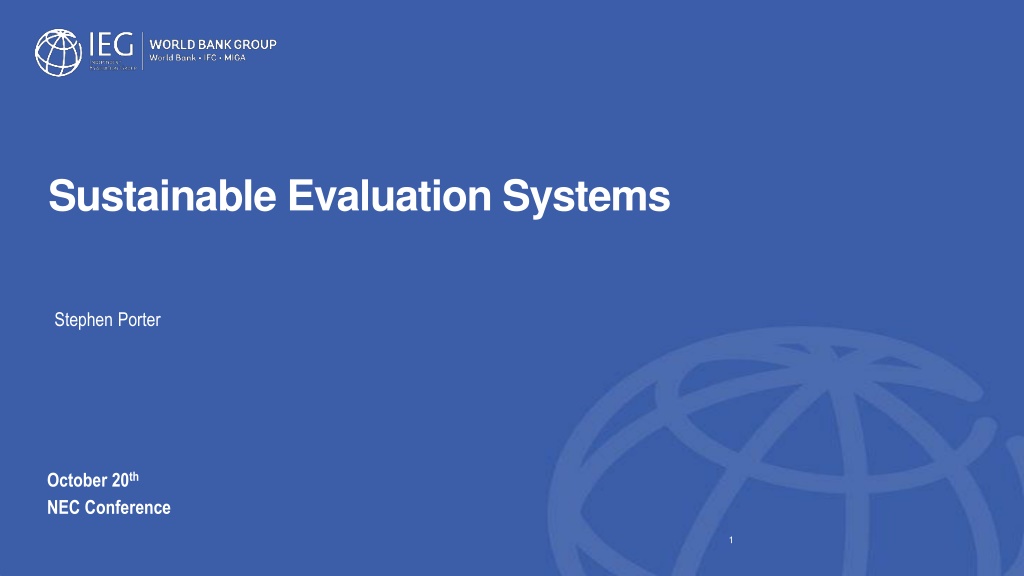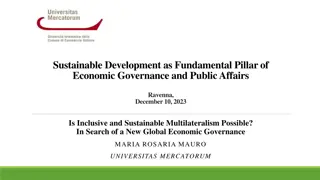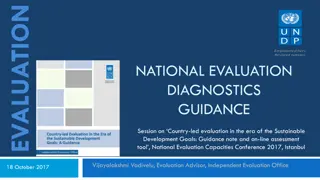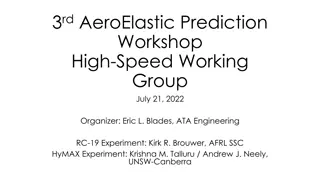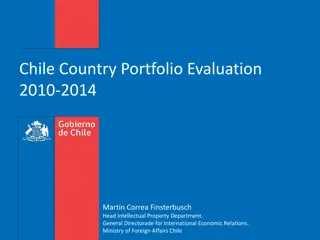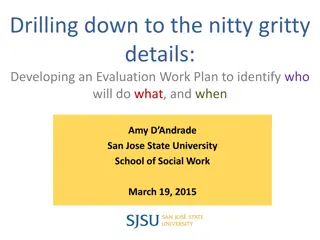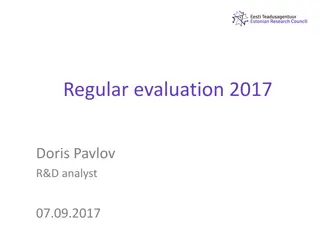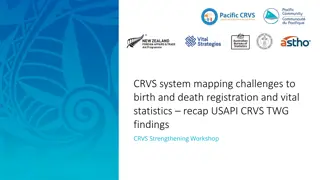Sustainable Evaluation Systems Workshop Summary
Workshop on Sustainable Evaluation Systems by Stephen Porter at the NEC Conference focused on defining evaluation systems, addressing their failures, and emphasizing the importance of quality, use, and networks in achieving sustainability. Participants engaged in activities such as bingo card introductions, stakeholder matrix discussions, and sharing their definitions of evaluation. Key objectives included understanding issues that hinder evaluation system sustainability, developing use-oriented organizational systems, tailoring quality expectations, and recognizing the role of networks. The workshop drew from research by Porter and Hawkins on sustainable organizational evaluation systems.
Download Presentation

Please find below an Image/Link to download the presentation.
The content on the website is provided AS IS for your information and personal use only. It may not be sold, licensed, or shared on other websites without obtaining consent from the author.If you encounter any issues during the download, it is possible that the publisher has removed the file from their server.
You are allowed to download the files provided on this website for personal or commercial use, subject to the condition that they are used lawfully. All files are the property of their respective owners.
The content on the website is provided AS IS for your information and personal use only. It may not be sold, licensed, or shared on other websites without obtaining consent from the author.
E N D
Presentation Transcript
Sustainable Evaluation Systems Stephen Porter October 20th NEC Conference 1
Introduction Definitions & Failures Summary Quality Use Networks Introductions Pickup your Bingo Cards The idea is to complete an X or a + on your bingo card Go round the room introduce yourself and ask people if a specific item on the bingo card refers to them The rules: Players have to get others to sign their Bingo card. Do not write another person s name for them. A person can only sign one box on a Bingo card Prizes will be awarded to the first two people to complete the pattern Independent Evaluation Group 2
Introduction Definitions & Failures Summary Quality Use Networks Objectives This workshop aims to provide participants with an understanding of: 1. 2. 3. 4. Issues that reduce sustainability of an evaluation system; Developing use orientated organizational evaluation systems; Tailoring quality expectations to the organizational context; and The role of networks in sustainable evaluation systems Workshop based on articles: Porter, S., & Hawkins, P. (2019). Achieving Sustainability Through Sustainable Organizational Evaluation Systems. New Directions for Evaluation, 2019(162), 87-101. Porter, S. (2016). A framework for improving the responsiveness of policy through development evaluation. Evaluation, 22(2), 245-258. Independent Evaluation Group 3
Introduction Definitions & Failures Summary Quality Use Networks Contents Time Session Introductions Definition Failures of an Evaluation System Break Use Stakeholder Matrix Use - Incentives Lunch Options on Systems Quality Break Example of Networks The role of networks in evaluation systems Close 09:00 09:30 09:30 10:30 10:30-11:00 11:00 13:00 13:00-14:00 14:00 15:30 15:30-16:00 16:00 17:15 17:15-17:30. Independent Evaluation Group 4
Introduction Summary Quality Use Networks Definitions & Failures Define Evaluation and a Successful Evaluation System In the handout write: your definition of evaluation; and what you think an evaluation system should achieve Share your thoughts with the person next to you Share with the room Independent Evaluation Group 5
Introduction Quality Use Networks Definitions & Failures Summary Define Evaluation and a Successful Evaluation System In this workshop evaluation is: The systematicand objectiveassessment of an on-going or completed project, programme or policy, its design, implementation and results. The aim is to determine the relevance and fulfilment of objectives, development efficiency, effectiveness, impact and sustainability. (OECD DAC, 2002) In this workshop it is argued that a successful/sustainable evaluation systems is: Use-focused Produces good quality evidenced Networked Independent Evaluation Group 6
Introduction Quality Use Networks Definitions & Failures Summary What causes an evaluation system to fail? 1. An aversion to the reality of results 2. Disfigured Accountability 3. Ritualization 4. Empty Rhetoric 5. Censorship Independent Evaluation Group 7
Introduction Quality Use Networks Definitions & Failures Summary Reliable evidence of results can be scary, as such, there can be an aversion to reality in organizations. Organizations operate with deeply held assumptions, which can result in them being resistant to evidence on certain subjects. 1. An aversion to the reality of results Without a high-quality evaluation system, evidence is less likely to come to the fore in a helpful manner
Introduction Quality Use Networks Definitions & Failures Summary Accountability is required for organizational systems to implement strategy in a coordinated manner. Disfigured accountability is where reporting procedures no longer allow honest reflection and discussion because of internal and external pressure 2. Disfigured Accountability Knowledge flows become impeded
Introduction Quality Use Networks Definitions & Failures Summary Evaluations are ritualized when they are provided to managers, but they are not taken into account in the actual decision process Paper is being pushed! Poor quality evaluation can trigger ritualization 3. Ritualization
Introduction Quality Use Networks Definitions & Failures Summary Real champions, who demand evaluations, are required for an evaluation system to function (Kusek & Rist, 2004). 4. Empty Rhetoric Sometimes, however, the rhetoric from ostensible champions on the use of evidence does not lead to the implementation of policies that support evaluation and is known to be a facade for other interests. They do this to build political capital, these managers will start to talk about the importance of evidence and evaluation; however, they will not allocate resources nor actually use evidence in decision-making
Introduction Quality Use Networks Definitions & Failures Summary An organization can have clear strategy, be accountable, and able to recognize failure, but choose to restrict evidence from evaluations through censorship. Censorship: Difficult approval processes placing evaluations on separate, hard-to-find websites, deletion of whole sections of reports or a refusal to publish reports. 5. Censorship
Introduction Summary Quality Use Networks Definitions & Failures Summary Five failures that affect evaluation system sustainability. 1. an aversion to the reality of results; 2. disfigured accountability; 3. ritualization; 4. empty rhetoric; and 5. censorship. Why do these challenge occur? How have you managed around these failures?
Introduction Summary Evaluation interacts with power Quality Use Networks Definitions & Failures Summary The commissioning of an evaluation by powerful groups who intend to use the findings in a decision is an outright act of power. Development evaluation can also be a process that produces alternatives for a policy agenda. An evaluation can be commissioned in order to help raise an issue. The definition of alternatives is the supreme instrument of power; because the definition of alternatives is the choice of conflicts, and the choice of conflicts allocates power (Schattschneider, 1960, p. 68)
Introduction Definitions & Failures Use Quality Networks Summary Use of Evaluations
Introduction Definitions & Failures Use Quality Networks Summary Use of Evaluations A sustainable evaluation system has products and processes that are useful. An evaluation system that is useful and used requires that there is demand for evaluations What is demand for evaluation?
Introduction Definitions & Failures Use Quality Networks Summary Stakeholders in your evaluation system Put 2 columns on the paper In column 1: List the stakeholders that you engage with in that evaluation system In column 2: Highlight the role that stakeholder plays in evaluation Discuss -What are the main groups of stakeholders? What are the main roles played?
Introduction Evaluation Capacity Matrix Evaluation Practice Requiring Capacity parties, Civil Society, the Definitions & Failures Use Quality Networks Summary Commissioners (Demand/ Intermediaries - Delivery and Supply principals) Management (Universities, think tanks, consultants) (Cabinet, Parliament, political (Central Government (Treasury etc.) Line departments (Health etc.). media, donors) User of Evaluations II III I Manager of Evaluations IV VI V Conducting evaluations VII VIII IX Adapted from Feinstein, 2011 Public Policies and State Capability Traps of the workshop on Evidence-Based Policy-Making And The Real World A Difficult Match? organized by the Cambridge Judge Business School, University of Cambridge, May 25th2011.
Introduction Definitions & Failures Use Quality Networks Summary Who do you engage with? Reflect on your evaluation system and populate your own matrix: Who are your main commissioners? What role(s) do they play? Who are intermediaries? What role(s) do they play? Who are suppliers? What role(s) do they play? Compare your matrix to others at our table Who are the main stakeholders in your evaluation system? Are there any gaps in practice? What are the challenges? What risks can you see given evaluation is political? Adapted from Feinstein, 2009
Introduction Definitions & Failures Use Quality Networks Summary Use and the Role of Incentives What motivates stakeholders? Carrots Sticks Sermons Lights Working across the matrix what incentives would you/have you put in place to help demand evaluation? Adapted from Feinstein, 2009
Introduction Incentives in Practice Evaluation Practice Requiring Capacity Definitions & Failures Use Quality Networks Summary Commissioners (Demand/ Intermediaries - Delivery and Supply principals) Management (Universities, think tanks, consultants) (Cabinet, Parliament, political parties, Civil Society, the media, donors) Recognition of outcome (Central Government (Treasury etc.) Line departments (Health etc.). User of Evaluations New information on project performance that can be used by other projects reporting Evangelize on evidence- based policy Manager of Evaluations Ratings feed into performance reporting Conducting evaluations Provide information about change or steer a project Adapted from Feinstein, 2009
Use Introduction Definitions & Failures Networks Quality Summary Quality
Use Introduction Definitions & Failures Networks Quality Summary Quiz What are the elements of a sustainable evaluation system? What is a carrot? Why do evaluation systems fail? Any questions from this morning?
Use Introduction Definitions & Failures Networks Quality Summary Two main elements of system quality Methodological Quality Process Quality
Use Introduction Definitions & Failures Networks Quality Summary Putting Quality into Practice South Africa Methods -Six types of evaluation, each with its own guidance Diagnostic Design Evaluation Implementation Economic Impact Evaluation Synthesis
Use Introduction Definitions & Failures Networks Quality Summary Putting Quality into Practice South Africa Process: Linked to AfrEA guidelines and OECD-DAC standards Steering Committee made up of interested parties and experts Work with a panel of evaluators to enable regular discussion of standards Reports to cabinet
Use Introduction Definitions & Failures Networks Quality Summary Putting Quality into Practice DFID Methods -Three types of evaluation, each with its own guidance Impact evaluationsestablish causal attribution in relation to an intervention and its effects Performance evaluationsevaluate the effectiveness of an intervention and itscontribution to development outcomes and impacts Process evaluationsprovide deeper understanding of the quality of implementation including integrity, relevance and coherence.
Use Introduction Definitions & Failures Networks Quality Summary Putting Quality into Practice DFID Process: Evaluation Quality Assurance and Learning System (EQuALS) rates quality against these types at ToR, Inception report and Final Draft Report (mandatory) Procurement against these types of evaluation Reference Group
Use Introduction Definitions & Failures Networks Quality Summary Your experience Review your matrix and reflect on: What processes do you have in place to manage quality? In which parts of the matrix do you have quality processes Anything you heard of interest?
Use Introduction Definitions & Failures Networks Quality Summary Summary When evidence of results challenges programs or managers wish to prevent the communication of findings, people are likely to challenge the quality of the evaluation. Quality standards help facilitate discussions and defense of evaluation: Mediate arguments provides a clearer basis for publication discuss reliability of evidence.
Use Quality Introduction Definitions & Failures Networks Summary Networks
Use Quality Introduction Definitions & Failures Networks Summary Networks Help Address Complex Problems Forms of networks including Coordination -information exchange Cooperation -Developing joint protocols Collaboration Using budget to develop joint systems Evaluation System Organization Central -IEG Embedded -DFID External Civil Society
Use Quality Introduction Definitions & Failures Networks Summary Networks Help Address Complex Problems More intense forms of collaboration in an evaluation system can help to: Build demand for evaluation, Support adaptive management, Improve quality. Resist pressures, such as not discussing results or censoring findings.
Use Quality Introduction Definitions & Failures Networks Summary Networks Help Address Evaluative Thinking Evaluative thinking is: critical thinking applied in the context ofevaluation, motivated by an attitude of inquisitiveness and a belief inthe value of evidence, that involves identifying assumptions, posingthoughtful questions, pursuing deeper understanding throughreflection and perspective taking, and I informing decisions inpreparation for action. Buckley, J., Archibald, T., Hargraves, M., & Trochim, W. M. (2015). Defining and teaching evaluative thinking: Insights from research on critical thinking.American Journal of Evaluation,36(3), 375-388.
Use Quality Introduction Definitions & Failures Networks Summary Experience from Colleagues
Use Quality Introduction Definitions & Failures Network Summary Course Summary
Use Quality Introduction Definitions & Failures Network Summary Objectives This workshop aims to provides participants with an understanding of: 1. 2. 3. 4. Issues that reduce sustainability of an evaluation system; Developing use orientated organizational evaluation systems; Tailoring Quality expectations to the organizational context; and The role of networks in sustainable evaluation systems Reviewing your matrix what have you learnt about an evaluation system? Independent Evaluation Group 37
Use Quality Introduction Definitions & Failures Network Summary Review In handout four write down: What have you found most useful? What experience from another person in the room struck you? What are the opportunities in your context for applying these tools? Examples in Handouts of Tools for Conducting Evaluation System Demand Diagnostics Independent Evaluation Group 38
